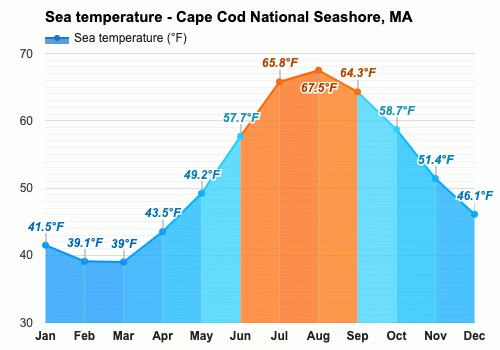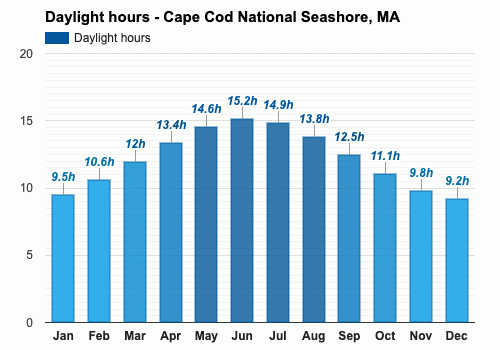Expand
Contents
- The climate of Cape Cod National Seashore
- The best time to visit Cape Cod National Seashore
- The worst time to visit Cape Cod National Seashore
- Spring weather in Cape Cod National Seashore
- Summer weather in Cape Cod National Seashore
- Autumn weather in Cape Cod National Seashore
- Winter weather in Cape Cod National Seashore
- Weather in January
- Weather in February
- Weather in March
- Weather in April
- Weather in May
- Weather in June
- Weather in July
- Weather in August
- Weather in September
- Weather in October
- Weather in November
- Weather in December
- Frequently asked questions
- Average sea temperature
- Average daylight
Climate and monthly weather forecast
The climate of Cape Cod National Seashore
Cape Cod National Seashore, Massachusetts, it comes under the classification "Cfa" as per the Köppen climate classification. This suggests it possesses a humid subtropical climate with no dry season. The geographical position and coastal influences mold its climate trends with some unique nuances. The variation in weather parameters throughout the year brings forth a distinct character to each season.
A survey through the year reveals variable sea temperatures and daylight hours. Sea temperatures fluctuate between 39°F (3.9°C) in February and a maximum of 67.5°F (19.7°C) in August. Notably, a mild progression in sea temperature is observed as winter progresses into summer. This pattern softens from late summer to winter once again, showcasing the cyclical nature of climatological trends. Meanwhile, daylight hours are initially low at 9.5 hours during January, peaking at 15.2 hours in June before gradually reducing towards the end of the year.
The Cape Cod National Seashore's climate exudes unique patterns. For instance, there is apparent escalation in daylight hours from winter to summer, peaking in June, and corresponding increase in sea temperatures. Inversely, as daylight hours truncate, there's a decrease in sea temperatures.
A survey through the year reveals variable sea temperatures and daylight hours. Sea temperatures fluctuate between 39°F (3.9°C) in February and a maximum of 67.5°F (19.7°C) in August. Notably, a mild progression in sea temperature is observed as winter progresses into summer. This pattern softens from late summer to winter once again, showcasing the cyclical nature of climatological trends. Meanwhile, daylight hours are initially low at 9.5 hours during January, peaking at 15.2 hours in June before gradually reducing towards the end of the year.
The Cape Cod National Seashore's climate exudes unique patterns. For instance, there is apparent escalation in daylight hours from winter to summer, peaking in June, and corresponding increase in sea temperatures. Inversely, as daylight hours truncate, there's a decrease in sea temperatures.
The best time to visit Cape Cod National Seashore
The idealistic time to visit Cape Cod National Seashore is typically between late July to early September when sea temperatures reach a comfortable range from 65.8°F (18.8°C) to 67.5°F (19.7°C). Concurrently, daylight hours also remain extended from 14.9 hours to 13.8 hours, allowing plenty of sun for outdoor activities. The enhanced sea temperatures during this period make it conducive for water-based adventures, from swimming to kayaking.
The worst time to visit Cape Cod National Seashore
Planning a visit during the coldest months, particularly from January to March, might not be optimal. Sea temperature oscillates between 39°F (3.9°C) and 43.5°F (6.4°C), making it quite chilly for marine activities. Correspondingly, daylight hours are reduced to 9.5 to 12 hours during these months restricting exploration and activities.
Spring weather in Cape Cod National Seashore
Spring season brings forth a gradual increase in both sea temperature and daylight hours. From March through May, sea temperatures rise from 39°F (3.9°C) to 49.2°F (9.6°C). Complementing this, daylight hours also show a notable increase from 12 hours to 14.6 hours. Spring flaunts a transitionary phase with progressively warmer and brighter days.
Summer weather in Cape Cod National Seashore
Summer season at Cape Cod National Seashore is a delightful experience. The sea temperature soars from 57.7°F (14.3°C) in June to its annual peak of 67.5°F (19.7°C) by August. Concurrently, the daylight hours achieve their maximum length from 15.2 hours in June to 13.8 hours by August end. This combination of warm sea and extended sunlight bless the national seashore with a quintessential summer.
Autumn weather in Cape Cod National Seashore
Autumn time conversely witnesses a decrease in both mentioned weather parameters. From September to November, the sea temperature reduces from 64.3°F (17.9°C) to 51.4°F (10.8°C), while the daylight hours shorten from 12.5 hours to 9.8 hours. The park experiences a calm, crisp transition with leaves changing hues and days becoming shorter.
Winter weather in Cape Cod National Seashore
Winter at Cape Cod National Seashore is marked by the year's coldest sea temperatures and shortest daylight hours. December witnesses a further plummet in sea temperature down to 46.1°F (7.8°C) by the end of the month. The daylight hours reduce to its yearly minimum at 9.2 hours. Despite minimal sunlight and lower sea temperatures, the beauty of the park during winters garners appraisals, particularly among winter sport enthusiasts.
Weather in January
Winter's grip descends steadily on Cape Cod National Seashore in January. Sea temperatures plummet to the low 41.5°F (5.3°C), their lowest of the year, making maritime activities less attractive. This month experiences a relatively robust transition into the New Year's winter, and one could expect less daylight—with just under 10 hours per day on average. Weather in January »
Weather in February
Despite the shortening of winter's tenure, February conditions at Cape Cod National Seashore maintain their chill, with similar characteristics as the preceding month. February sees the sea temperatures drop slightly further, landing at an average of 39.1°F (3.9°C). Weather in February »
Weather in March
March invariably initiates the weather change in Cape Cod National Seashore. Sea temperatures barely shift from the previous month, stabilizing around 39°F (3.9°C). However, daylight hours noticeably increase, averaging 12 hours daily—providing welcome relief from the longer winter nights. Weather in March »
Weather in April
With spring in full blossom, April presents Cape Cod National Seashore with significant improvements compared to March. The sea temperature sees a rise, reaching an average of 43.5°F (6.4°C). Alongside the climbing temperature trend, daylight hours stretch further, with nearly 13.5 hours per day on average. Weather in April »
Weather in May
May amplifies the spring signals in the Cape Cod National Seashore area. The month observes a lasting increase in sea temperatures, signaling a definitive departure from the colder months. Daily average daylight extends further, making room for increased outdoor activities. Weather in May »
Weather in June
June inaugurates the summer at Cape Cod National Seashore. The sea temperature heads into the 50s°F, with an average of 57.7°F (14.3°C), which is a significant jump from May. Daylight hours peak with more than 15 hours a day—indicating longer days and shorter nights. Weather in June »
Weather in July
July epitomizes summer at Cape Cod National Seashore, presenting maximum sea temperatures for the year. With the sea warming up to an average of 65.8°F (18.8°C), the month is favorable for water activities. Daylight hours remain abundant, just slightly less than June, enhancing outdoor endeavors. Weather in July »
Weather in August
August continues the peak summer conditions at Cape Cod National Seashore. The sea temperature reaches another high, with an average of 67.5°F (19.7°C) marking the warmest in the year. Daylight hours start their gradual decline from the peak in June and July but remain significant. Weather in August »
Weather in September
September brings a changing wind to Cape Cod National Seashore as summer cools off and autumn approaches. The month's sea temperatures retreat slightly to an average of 64.3°F (17.9°C). Daylight hours continue to shrink, dropping to nearly half of July's length. Weather in September »
Weather in October
With the arrival of October, Cape Cod National Seashore welcomes the vibrancy of fall. Sea temperatures dip to an average of 58.7°F (14.8°C) indicating cooling waters. The sunlight is less generous with the daylight hours flagging down to just above 11 hours. Weather in October »
Weather in November
November ushers in a discerning shift towards winter at Cape Cod National Seashore. The sea temperatures spiral down to an average of 51.4°F (10.8°C), pointing to cooler maritime conditions. Daylight hours continue to peter out at just under 10 hours. Weather in November »
Weather in December
December marks the return of winter conditions at Cape Cod National Seashore. With a significant plunge in sea temperature to 46.1°F (7.8°C), the cold weather asserts its dominance. Daylight diminishes, averaging 9.2 hours per day, creating shorter days and longer nights. Weather in December »
Updated: Jun 4, 2024
Published by: Weather U.S. | About Us
Data Sources | Weather Forecasting & Climate
Published by: Weather U.S. | About Us
Data Sources | Weather Forecasting & Climate
Frequently asked questions
When is the ocean coldest?
March is the month with the coldest seawater, with an average ocean temperature of 39°F (3.9°C).
When is Daylight Saving Time (DST) in Cape Cod National Seashore?
On Sunday, March 10. 2024, at 2:00 am, Daylight Saving Time starts, and the time zone changes from EST to EDT. Daylight Saving Time ends Sunday, November 3. 2024, at 2:00 am, and the time zone reverts from EDT to EST.
When are the longest days?
The month with the longest days is June, with an average of 15h and 12min of daylight.
What is the month with the warmest ocean?
With an average ocean temperature of 67.5°F (19.7°C), August is the month with the warmest seawater.
What is the month with the shortest days?
With an average of 9h and 12min of daylight, December has the shortest days of the year.

Average sea temperature
Cape Cod National Seashore, MA
The best month for swimming (with the highest average sea temperature) is August (67.5°F).
The coldest month (with the lowest average sea temperature) is March (39°F).

Average daylight
Cape Cod National Seashore, MA
- Average daylight in January:
9h and 3min - Average daylight in February:
10h and 4min - Average daylight in March:
12h and 0min - Average daylight in April:
13h and 2min - Average daylight in May:
14h and 4min - Average daylight in June:
15h and 1min
- Average daylight in July:
14h and 5min - Average daylight in August:
13h and 5min - Average daylight in September:
12h and 3min - Average daylight in October:
11h and 1min - Average daylight in November:
9h and 5min - Average daylight in December:
9h and 1min
The month with the longest days is June (Average daylight: 15h and 12min).
The month with the shortest days is December (Average daylight: 9h and 12min).